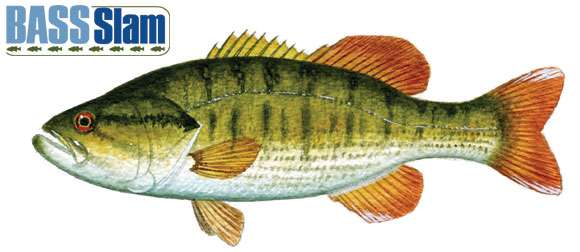
Each angler will have a unique set of challenges in completing the BASS Slam, but there may be one common frustration: the redeye bass. When Bassmaster Editor James Hall, BASS Conservation Director Chris Horton and I trekked through the Southeast in search of all eight black bass species, a keeper redeye eluded us. When we spoke to Dr. Steve Sammons, a local angler and research fellow at Auburn University, he wasn't surprised to hear we couldn't manage a 12-inch redeye … and he quickly suggested the bar was set too high.
"I've worked with — and fished for — redeyes since 1995, and to catch a 12-inch fish would be amazing. You just don't see many that big," Sammons says. "They are small to begin with and grow slowly. An 8-inch specimen is likely five or six years old. I've always said they're the brook trout of bass; you admire how pretty they are and don't worry about the size."
Your Slam just got easier.
MICROPTERUS COOSAE
The range of M. coosae is somewhat small. They can be found from northeastern Mississippi to northwest Georgia, with the greatest concentration in north Alabama and into southern Tennessee. Sammons has had 30-fish days on small, shoaly streams in Tennessee. He says the redeye is very different than the other basses and fills out its niche through its habitat.
"They are small stream specialists. I think this is why they've survived in areas where there are other bass; they occupy parts of the stream other bass can't," he says. "You really want bream tackle when going after these things. I like a light action spinning rod with 6- or 8-pound-test line and will flip a 2-inch grub or No. 1 in-line spinner into the fastest moving areas of a shoal I can find."
WHAT TO EXPECT
On our Slam trek, Sammons and Horton registered the only redeyes among the four of us. Both were 7 to 8 inches, average specimens. He recommends small streams for good numbers of redeyes and larger creeks or small rivers for larger fish.
The record redeye bass was caught in 2000 from Choccolocco Creek in Talladega County, Ala., and weighed 3 pounds, 2 ounces.
WHAT SETS IT APART
A bass with red eyes doesn't necessarily mean you have a redeye. While this is a characteristic, many spotted bass and smallmouth have red eyes, as well. The best identifier is the fins. They may have a red tint to them and will have white margins, or edges. If a questionable bass doesn't have red eyes, don't discount it, either. Not all redeyes have red eyes. Water clarity goes a long way in determining the coloration of fish.
BEWARE BARTRAM's BASS
As of this writing, experts recognize only one redeye bass species, and these fish inhabit northeast Mississippi to northwestern Georgia. However, South Carolina (specifically the drainages of the Savannah River and even Lake Hartwell) also has some fish called redeyes. They are a genetically distinct species but have yet to be officially recognized as such, which means they are not included in the 2009 version of the BASS Slam. These fish are also called Bartram's bass, and for now they do not count as redeyes.
Sammons says it is unclear when these fish will be recognized as a distinct species, but he believes they will be.
"If you look at these things, they look like nothing you've ever seen. The splotches are completely different than the redeye," he says. "Redeye bass don't tolerate impoundments well at all, and the fact that these are found in Hartwell is pretty solid evidence they're their own species."
Until scientists verify the distinction, the Bartram's bass will count in the spotted bass category of the BASS Slam.




